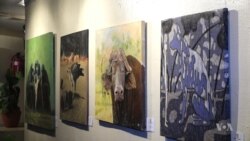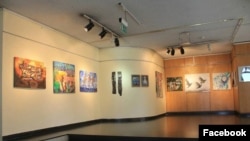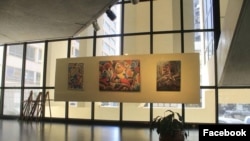Two African dancers in tribal costumes and painted faces — one man and one woman — alternate between strong, gyrating movements and slow, smooth motions before a small crowd at the opening of the 8th East Africa Art Biennale in Nairobi, hosted by the French cultural organization, Alliance Francaise.
Halfway through the performance, the male dancer singles out females in the crowd, some foreign and some local, and one by one takes them to the floor. The perplexed volunteers try to figure out if they are to wait for instructions, mimic the male dancer's unclear movements, or do their own dance. A parallel could be drawn between the varied reactions and East Africa's contemporary art scene — emerging slowly and step-by-step.
Behind the dancers, large contemporary paintings on the wall depict interpretations of modern life in Africa — one of them an old woman in a village reading a book titled How to Get Rich.
Africa's traditional arts are making room for the contemporary — and East Africa is no exception.
"Wow, it's blossomed," declared Kenyan arts and culture TV presenter Evie Maina, when asked about the growth and development of East Africa's contemporary art scene. "Fantastic and beautiful, and it's just blossomed from how it was five years ago … very few artists participating in an event like this to now, there's all these artists that are here today."
The region's emerging talent was on display at the traveling exhibit, opened for the first time in Kenya's capital. Titled Moving Art across East Africa Borders, the show features works by 62 artists from 11 countries and aims to promote East Africa's emerging artistic talent.
The Tanzania-based show includes works from Europe and greater Africa, but focuses on promoting East African artists and their culture.
"From the history of East Africans, that uniqueness, that unique thing need[s] to be seen by the world," said Kiagho Kilonzo, director of the show. "So, we thought the East African artists, although most of them do not have — we call these folk artists — most of them do not have a lot of formal education, they use talent. But that talent make[s] them unique."
Artists
A few years ago, Joy Maringa began displaying her talent as a make-up and lip artist. Her short, dyed-yellow hair and painted, dark violet lips stand out — even in a room full of artistic and fashionable types — and draw attention to her medium.
"It's different," replied Maringa when asked why she focuses on lips. "I love lips. It's ignored. Most people don't want to talk about lips normally. And, I thought it was the best canvas for me."
Paper-quilling Kenyan artist Fatima Qureish rolls thin strips of paper into different shapes and arranges them into decorative designs or depictions — such as a small giraffe displayed on the wall.
"Actually, I just started to decorate cards and envelopes and small things for friends and family," she said. "And, they really pushed me, like, 'You should be doing something bigger.' And, that's when I tried to do this art."
Other artists send social and political messages that resonate globally.
Visitors
Dara Wise is visiting East Africa to get in touch with the culture as an African-American, and was moved by one painting, in particular.
"There's an image of [former U.S. president] Barack Obama and he's holding a woman, and I see the woman as Mother Africa, it's like, I believe, 'Welcoming Home,'" Wise said. "And, for me, Obama is home. But, America no longer feels like home as the president that we have now."
As an American, Wise says she gets a lot of negative images about Africa. But she came to East Africa to see it for herself, "going in with a blank canvas" and "holding the brush" to paint her own image. She describes the results as "absolutely beautiful" and "humbling."
Dressed to the nines in a suit he says a friend designed, Kenyan artist Ken Othiam Omam, a visitor to the exhibit, tells VOA that East African art is taking baby steps onto the world stage.
"Like the African Art Fair in London, which had few Kenyan artists and few artists from Africa, which was more interesting [be]cause actually, [to] be honest now seeing like this, there's actually much of talent in art in Kenya and East Africa as a whole," Omam said.
The interest is mostly because it's undiscovered, says arts and culture TV presenter Maina.
"Because of that, it's like new to everybody," she said. "It's new to the artist, it's new to, you know, like, consumers of art. It's just new to everyone and it's different."










